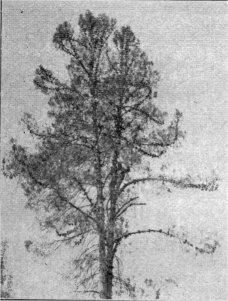
[click to enlarge]
| Online Library: | Title | Author | California | Geology | History | Indians | Muir | Mountaineering | Nature | Management |
Yosemite > Library > Cone-bearing Trees > Knobcone Pine >
Next: Western Yellow Pine • Contents • Previous: Digger Pine
Pinus attenuate Lemmon.

[click to enlarge] |
In response to such a precarious racial existence, Knobcone Pines bear fruit at a surprisingly early age. Sugar Pines do not produce cones until they are trees eighty feet high or more, or when they are about seventy-five years old. The Knobcone Pine, however, ripens its first cones when a mere sapling two or three feet high and between three to eight years of age. The first crops of cones are attached to the main axis in whorls and persist on the tree until either the increase in size of the trunk breaks them off or embeds them in the wood. Occasionally a tree is found with the tips of the lower cones barely showing through the bark while the progressively younger cones higher up are less and less embedded.
In the Tree Room of the Yosemite Museum there is exhibited a section of a Knobcone Pine trunk with a cone nearly surrounded with wood. When the tree was alive a new layer of wood was laid down just beneath the bark each year. By this growing process cones which remained attached to trunks were more and more embedded as the trees increased in diameter.
Another singular phenomenon, not much less remarkable than the persistence of the cones, is the vitality of the seeds which show a high rate of germination regardless of age. Cones which have been removed from the wood where they have been embedded many years during the life of the tree contain seeds with essentially as high a degree of germination as those found in the younger exposed cones.
Knobcone Pines are the most sparingly represented conifers in the forests of Yosemite. To our knowledge there are less than a dozen of them in the park and they were discovered only recently. The four places where they are known to occur are widely separated and difficult of access. One tree is growing on the steep sidewall several hundred yards beyond and below the west portal of the Wawona Tunnel and cannot be seen except by a precipitous descent. Other locations are in more open terrain: one tree is on the little used fire road to Deer Camp; another grows in the forestry sample plot at Grouse Creek; and several are to be found above Big Meadows at the junction of the Coulterville Road and the Davis Cutoff. Two large specimens, however, grow at El Portal near the All-Year Highway. One may be seen among Western Yellow Pines about fifty feet from the road just one-tenth of a mile below the El Portal store. Three-tenths of a mile farther down, between the road and the river, stands another Knobcone Pine. They might be mistaken for Digger Pines, but can be distinguished by the presence of clusters. of small cones that encircle the trunks and larger branches. Digger Pine cones are considerably larger and bulkier and never so numerous.
The typical shape of the Knobcone Pine tree depends upon whether they are growing in open or in dense stands. When found alone these trees have broad crowns and trunks forked near the middle, much like, but smaller than, the Digger Pines. The grove form is slender and graceful with the ascending branches in whorls at regular intervals.
The leaves are pale yellow-green, and quite short (three to five inches) for a three-needled pine. Like the Digger Pines the needles droop but are more evenly distributed along the smooth light brown colored branches, rather than tasseled at the ends.
Trunks of old trees are covered with thin, dull, gray-brown bark that is shallowly furrowed. They seldom attain diameters much over twelve inches, and in the Yosemite region trees forty-five feet high are considered large, although the specimen near the tunnel is sixty-five feet high and fourteen inches in diameter. The two trees at El Portal are about sixty feet high.
These little known pines are very interesting. They are seldom seen since they are restricted to local, frequently inaccessible areas in Oregon and California. Their very scarcity should make them sought out. Admirers of trees will appreciate Knobcone Pines the more when they understand under what seemingly adverse conditions they live and persist from generation to generation.
Next: Western Yellow Pine • Contents • Previous: Digger Pine
| Online Library: | Title | Author | California | Geology | History | Indians | Muir | Mountaineering | Nature | Management |
http://www.yosemite.ca.us/library/cone-bearing_trees/knobcone_pine.html